LS-Dyna Impact Modelling on Carbon Fibre Reinforced Polymers (CFRP) Composite Aircraft Panel with Various Impactors †
Abstract
:1. Introduction
2. Modelling of Composite Panel with Impactor
Solid Modelling
3. Results and Discussion
3.1. Spherical Impactor
3.2. Conical Impactor
3.3. Ogival Impactor
4. Conclusions
Author Contributions
Funding
Institutional Review Board Statement
Data Availability Statement
Acknowledgments
Conflicts of Interest
References
- Kowshik, S.; Gowrishankar, M.C.; Shettar, M.; Bhat, R.; Gurumurthy, B.M. Durability prediction analysis on mechanical properties of GFRP upon immersion in water at ambient temperature. Cogent Eng. 2021, 8, 1956869. [Google Scholar] [CrossRef]
- Shettar, M.; Kowshik, S.; Hiremath, P.; Sharma, S. Water sorption-desorption-resorption effects on mechanical properties of epoxy-nanoclay nanocomposites. Int. J. Automot. Mech. 2022, 19, 9478–9486. [Google Scholar] [CrossRef]
- Gayathri, R. Design and characteristics study of an aircraft tapered wing. Int. J. Mech. Eng. 2022, 7, 6985–7000. [Google Scholar]
- Heimbs, S.; Heller, S.; Middendorf, P.; Hähnel, F.; Weiße, J. Low velocity impact on CFRP plates with compressive preload: Test and modelling. Int. J. Impact Eng. 2009, 36, 1182–1193. [Google Scholar] [CrossRef]
- Hou, Y.; Li, C.; Zhou, X.; Sapanathan, T.; Rachik, M. An insight into the low-velocity impact behavior of patch-repaired CFRP laminates using numerical and experimental approaches. Compos. Struct. 2018, 190, 179–188. [Google Scholar]
- Icten, B.M.; Kıral, B.G.; Deniz, M.E. Impactor diameter effect on low velocity impact response of woven glass epoxy composite plates. Compos. B Eng. 2013, 50, 325–332. [Google Scholar] [CrossRef]
- Jims John Wessley, G.; Gaith Franklin, A.; Vijay, S.J. Fabrication and Mechanical Characterization of Stir CastAA6063-Borosilicate-Fly Ash Hybrid Metal Matrix Composites. Int. J. Eng. Technol. 2018, 7, 101–105. [Google Scholar] [CrossRef]
- Mo, G.L.; Ma, Q.W.; Jin, Y.X.; Li, Z.X.; Wu, Z.L. Delamination process in cross-ply UHMWPE laminates under ballistic Penetration. Def. Technol. 2021, 17, 278–286. [Google Scholar] [CrossRef]
- Mo, Y.; Ge, D.; He, B. Experiment and optimization of the hat-stringer-stiffened composite panels under axial Compression. Compos. B. Eng. 2016, 84, 285–293. [Google Scholar] [CrossRef]
- Nishikawa, M.; Hemmi, K.; Park, S.; Nadabe, T.; Takeda, N. Finite Element Analysis on the Impact-Induced Damage of Composite Fan Blades Subjected to a Bird Strike. Trans. Jpn. Soc. Aeronaut. Space Sci. 2010, 58, 261–268. [Google Scholar] [CrossRef]
- Rajamanickam, R. Study of Delamination of Composite Hat Skin Stringer Interface Failure. Master’s Thesis, Blekinge Institute of Technology, Karlskrona, Sweden, 2019. [Google Scholar]
- Rakesh, P.K.; Sharma, V.; Singh, I.; Kumar, D. Delamination in Fiber Reinforced Plastics: A Finite Element Approach. Engineering 2011, 03, 549–554. [Google Scholar] [CrossRef]
- Ambri, A.; Kaur, R. Spars and Stringers-Function and Designing Ambri Student (Aerospace). Int. J. Aerosp. Eng. 2014, 1, 58–61. [Google Scholar]
- Winkel, J.D.; Adams, D.F. Instrumented drop weight impact testing of cross-ply and fabric composites. Compos 1985, 16, 268–278. [Google Scholar] [CrossRef]
- Xu, W.; Liu, L.; Xu, W. Experiments and Finite Element Simulations of Composite La9minates Following Low Velocity On-Edge Impact Damage. Polymers 2022, 14, 1744. [Google Scholar] [CrossRef]
- Zhou, J.; Liao, B.; Shi, Y.; Zuo, Y.; Tuo, H.; Jia, L. Low-velocity impact behavior and residual tensile strength of CFRP laminates. Compos. B Eng. 2019, 161, 300–313. [Google Scholar] [CrossRef]
- Gonzalez-Jimenez, A.; Manes, A.; Beligni, A.; Dziendzikowski, M.; Sbarufatti, C.; Giglio, M. Modelling and experimental testing of thick CFRP composites subjected to low velocity impacts. Procedia Struct. Integr. 2019, 24, 101–109. [Google Scholar] [CrossRef]
- Sommer, D.E.; Thomson, D.; Falcó, O.; Quino, G.; Cui, H.; Petrinic, N. Damage modelling of carbon fibre composite crush tubes: Numerical simulation and experimental validation of drop weight impact. Compos. Part A Appl. Sci. Manuf. 2022, 160, 107033. [Google Scholar] [CrossRef]
- Colamartino, I.; Bassi, S.M.; Benetton, D.; Anghileri, M. A Semi-Empirical Damage Evaluation Criterion for Thin Composite Impact Analysis. J. Dyn. Behav. Mater. 2022, 8, 424–436. [Google Scholar] [CrossRef]
- Falzon, B.G. Computational modelling of the crushing of carbon fibre-reinforced polymer composites. Philos. Trans. R. Soc. A 2022, 380, 20210336. [Google Scholar] [CrossRef]
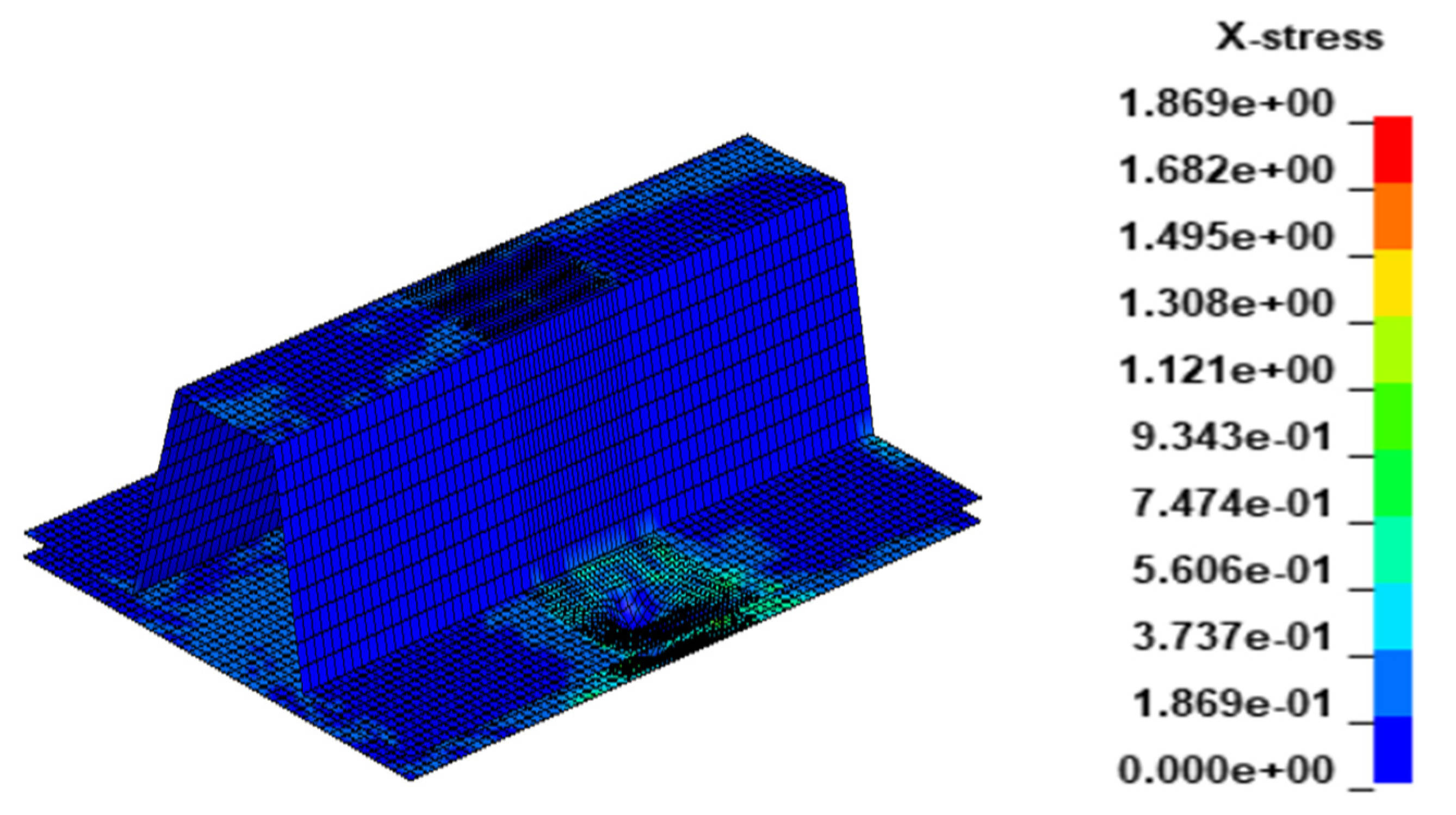

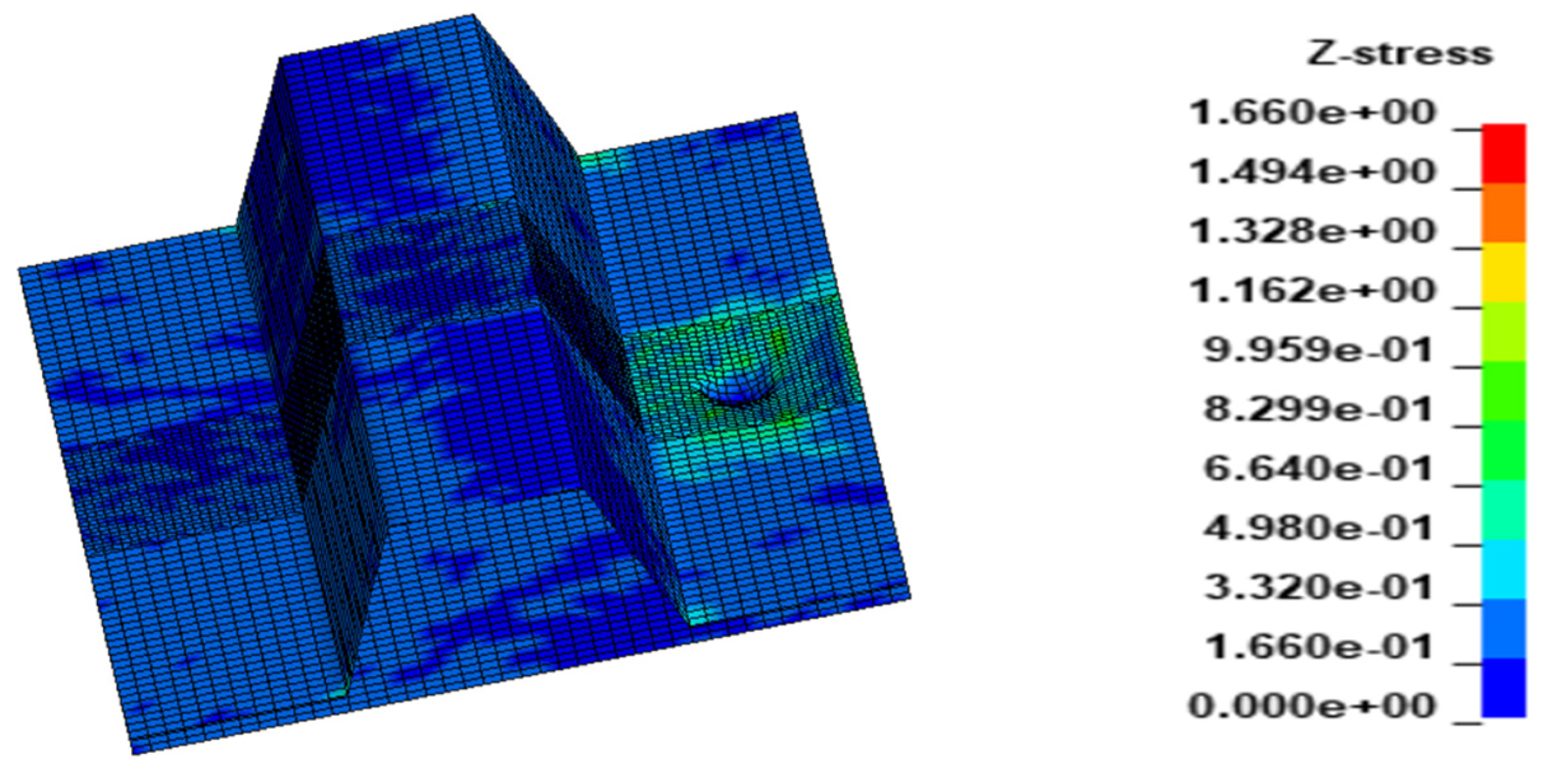
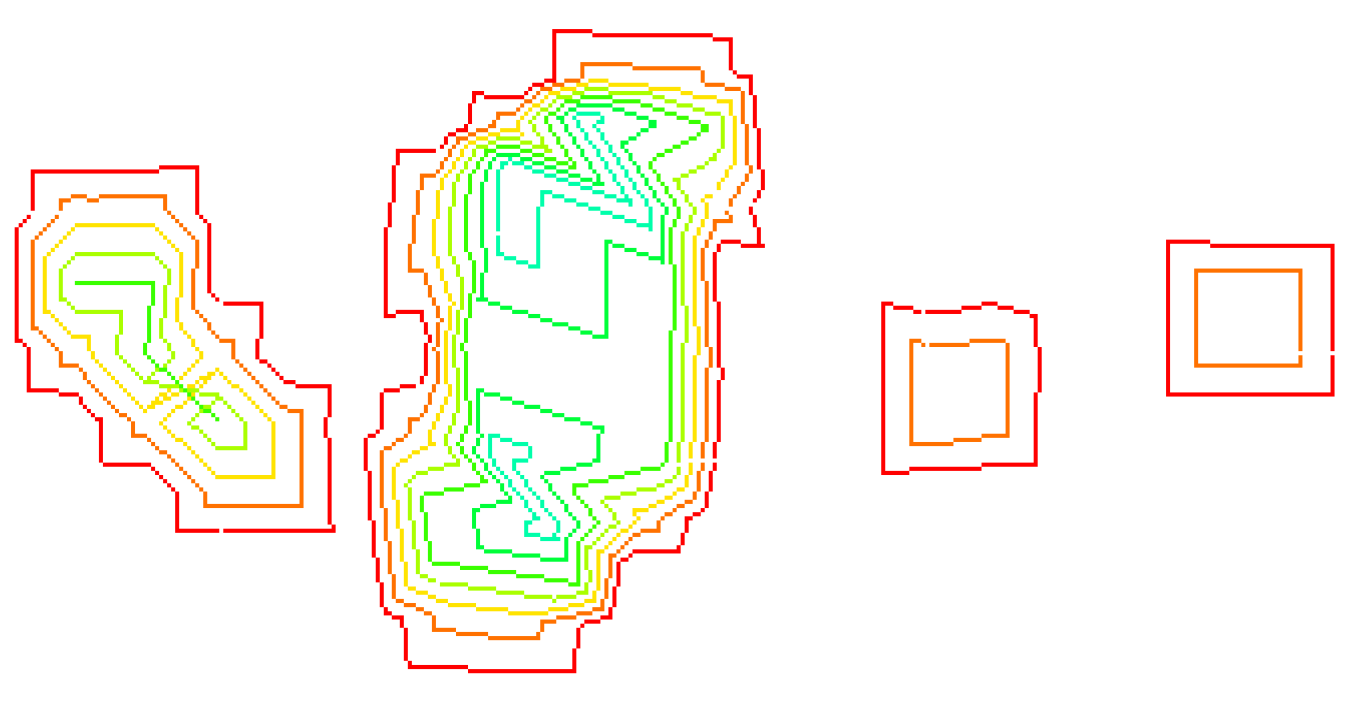


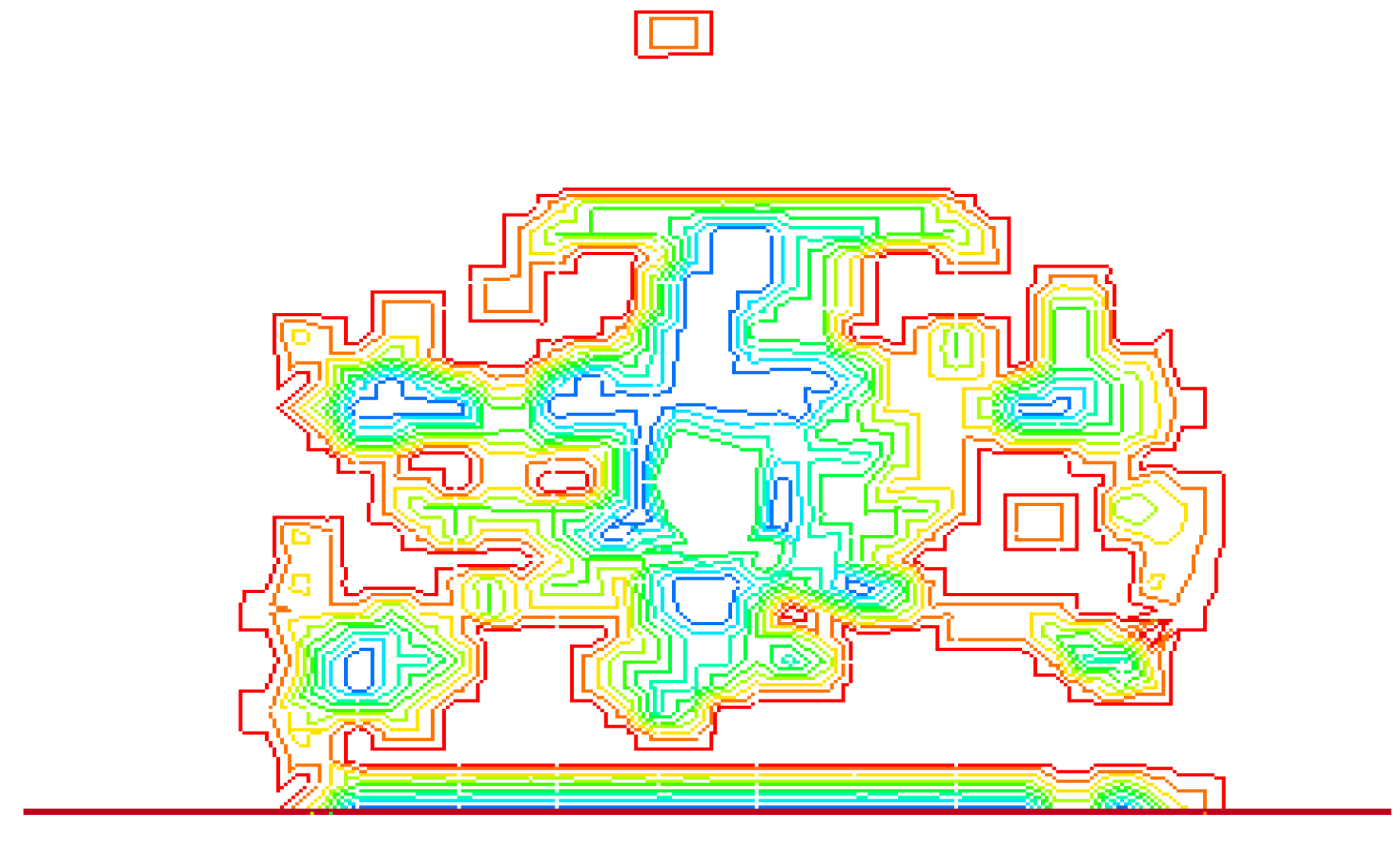
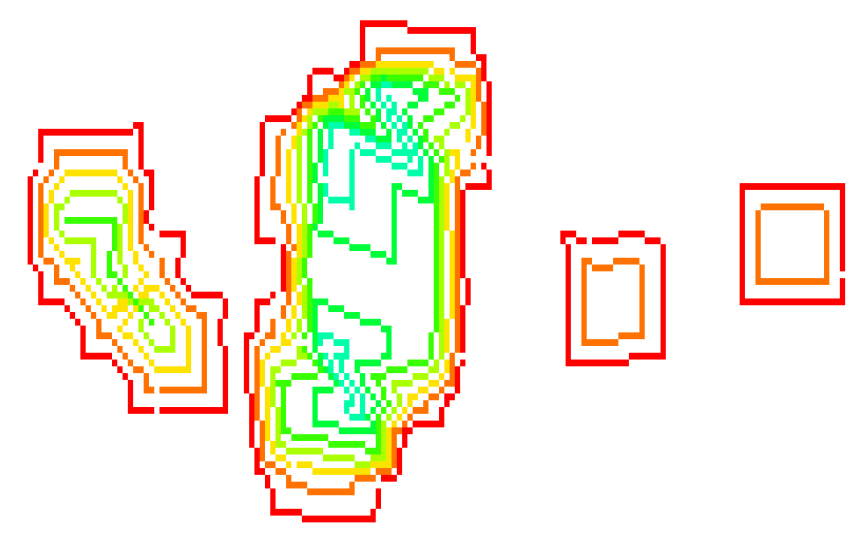


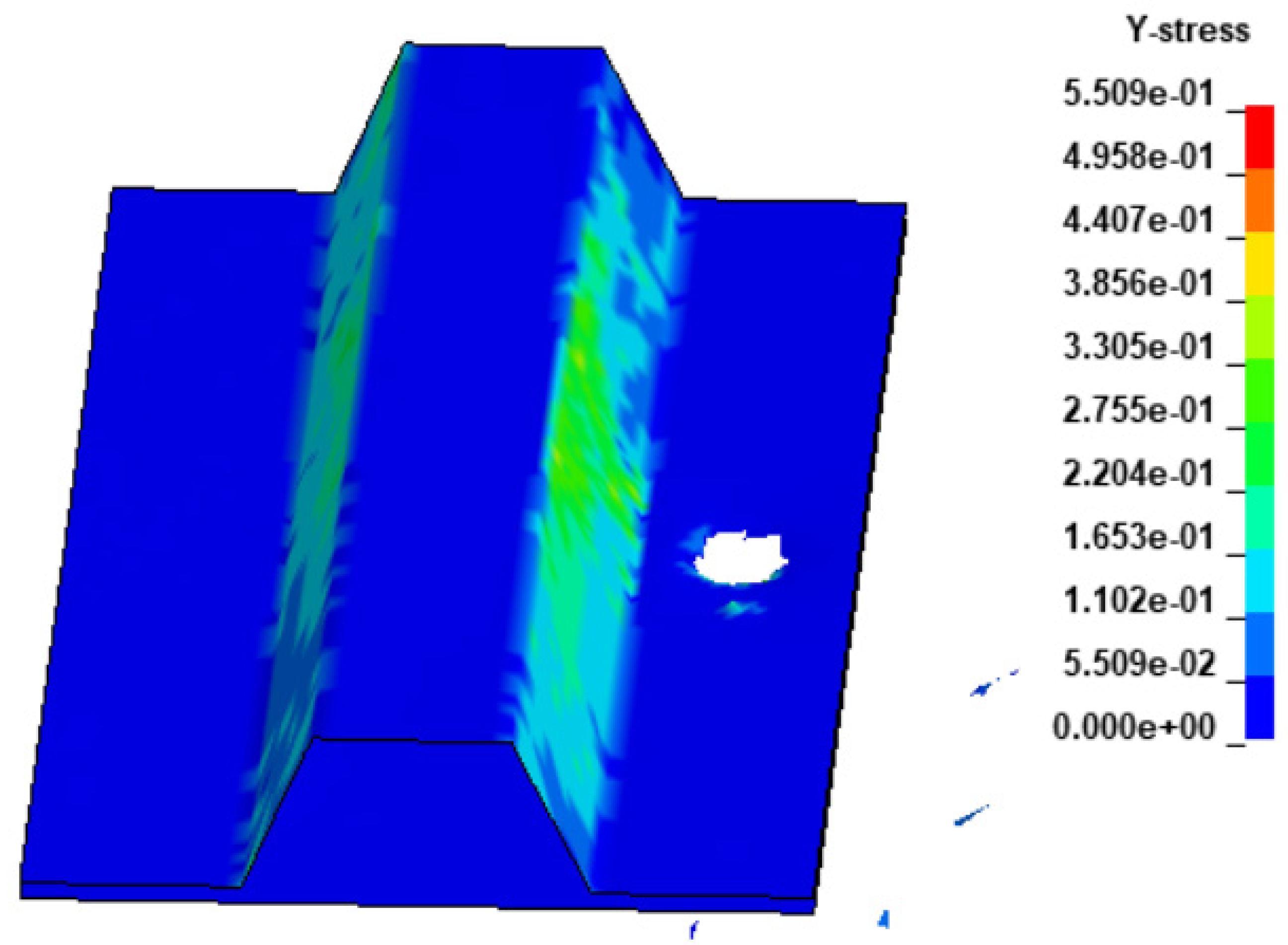
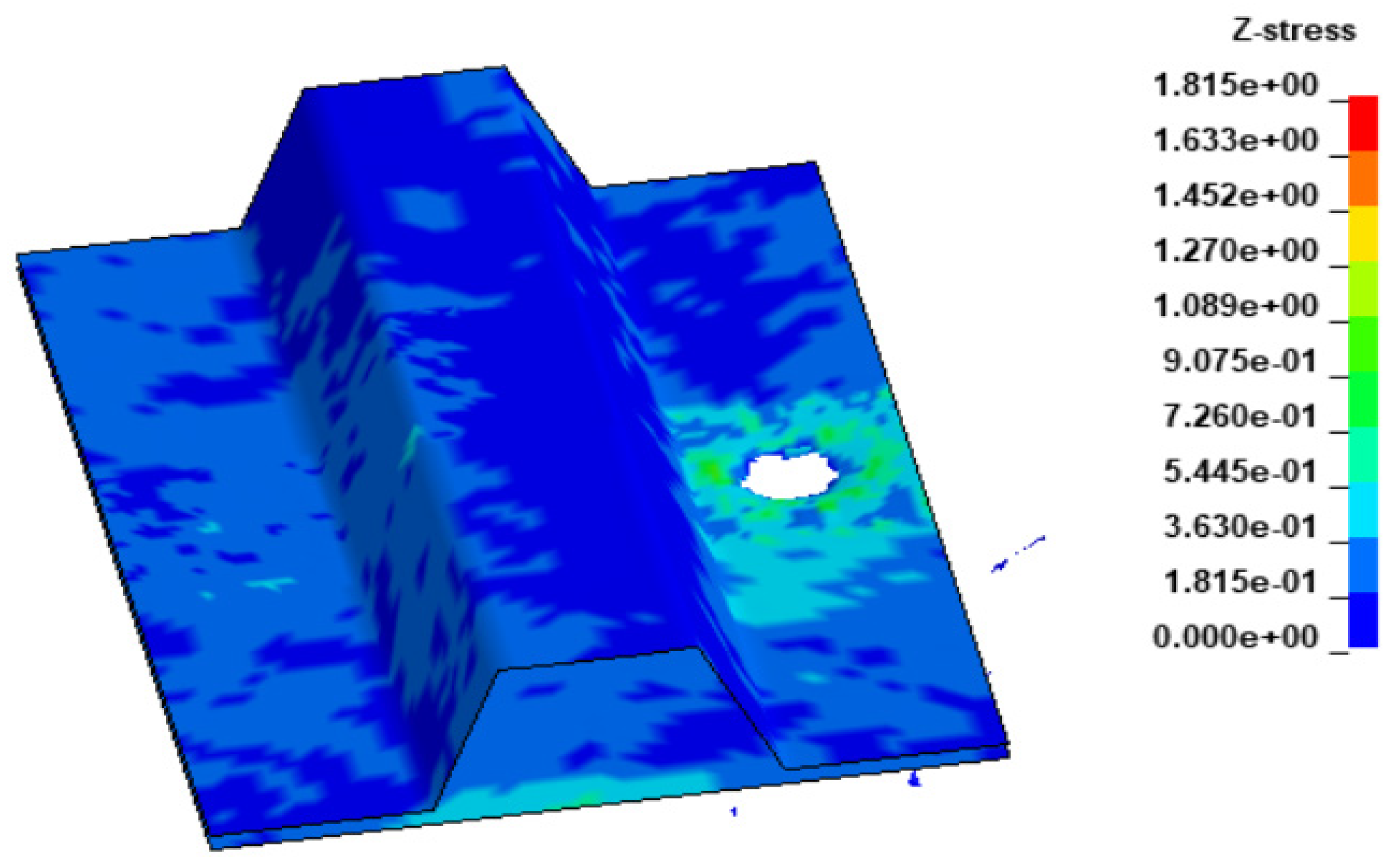
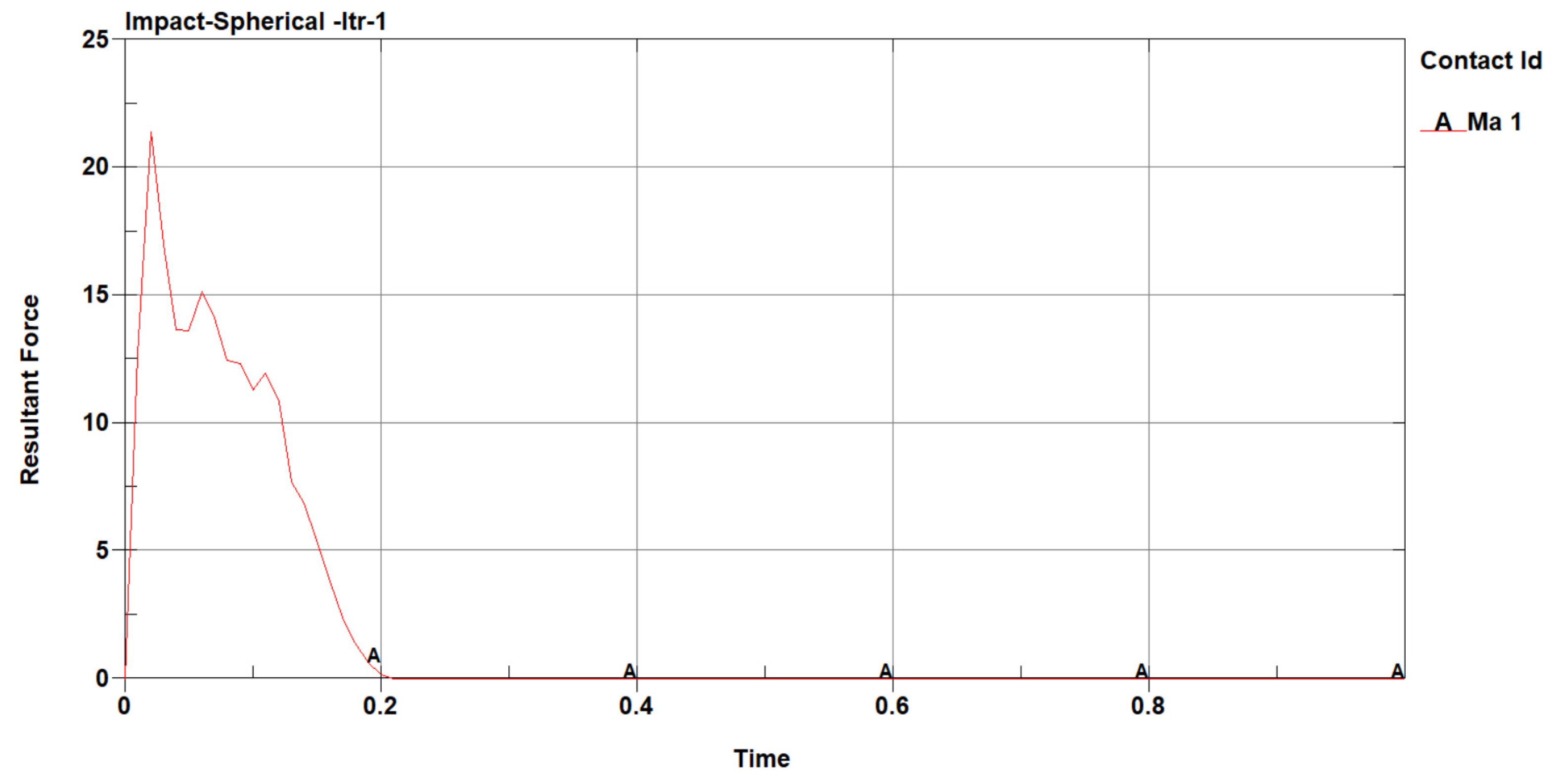


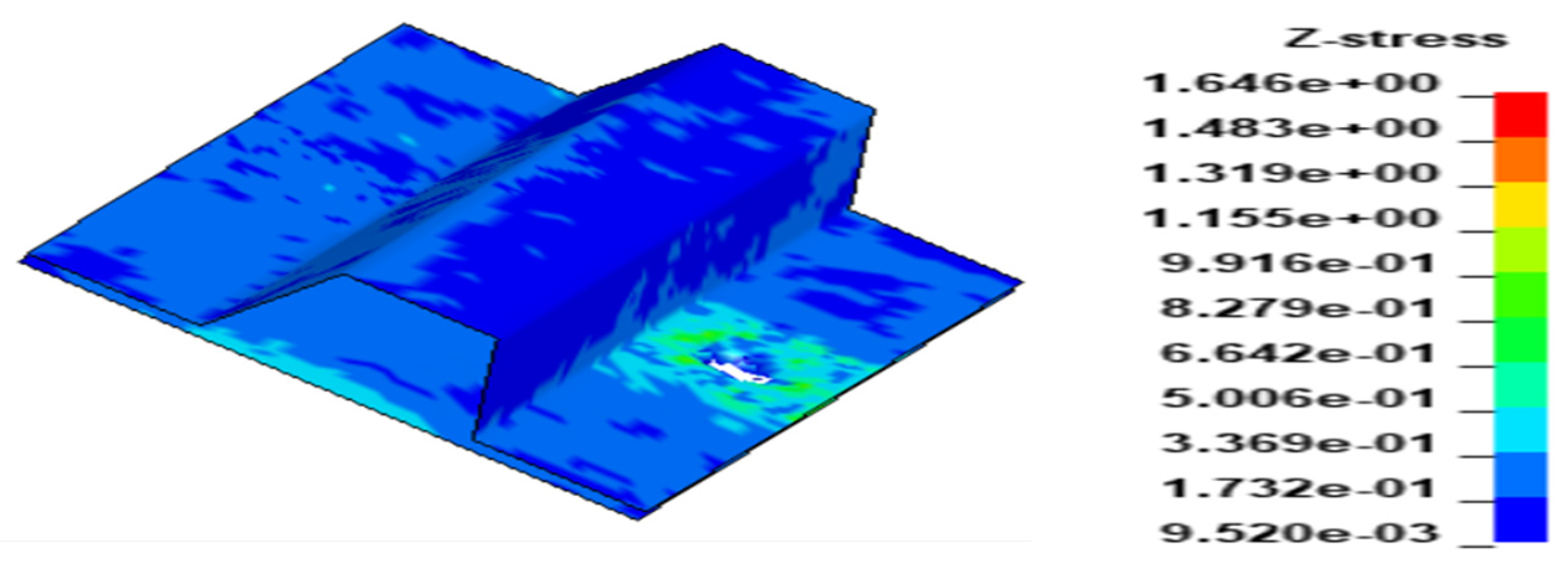
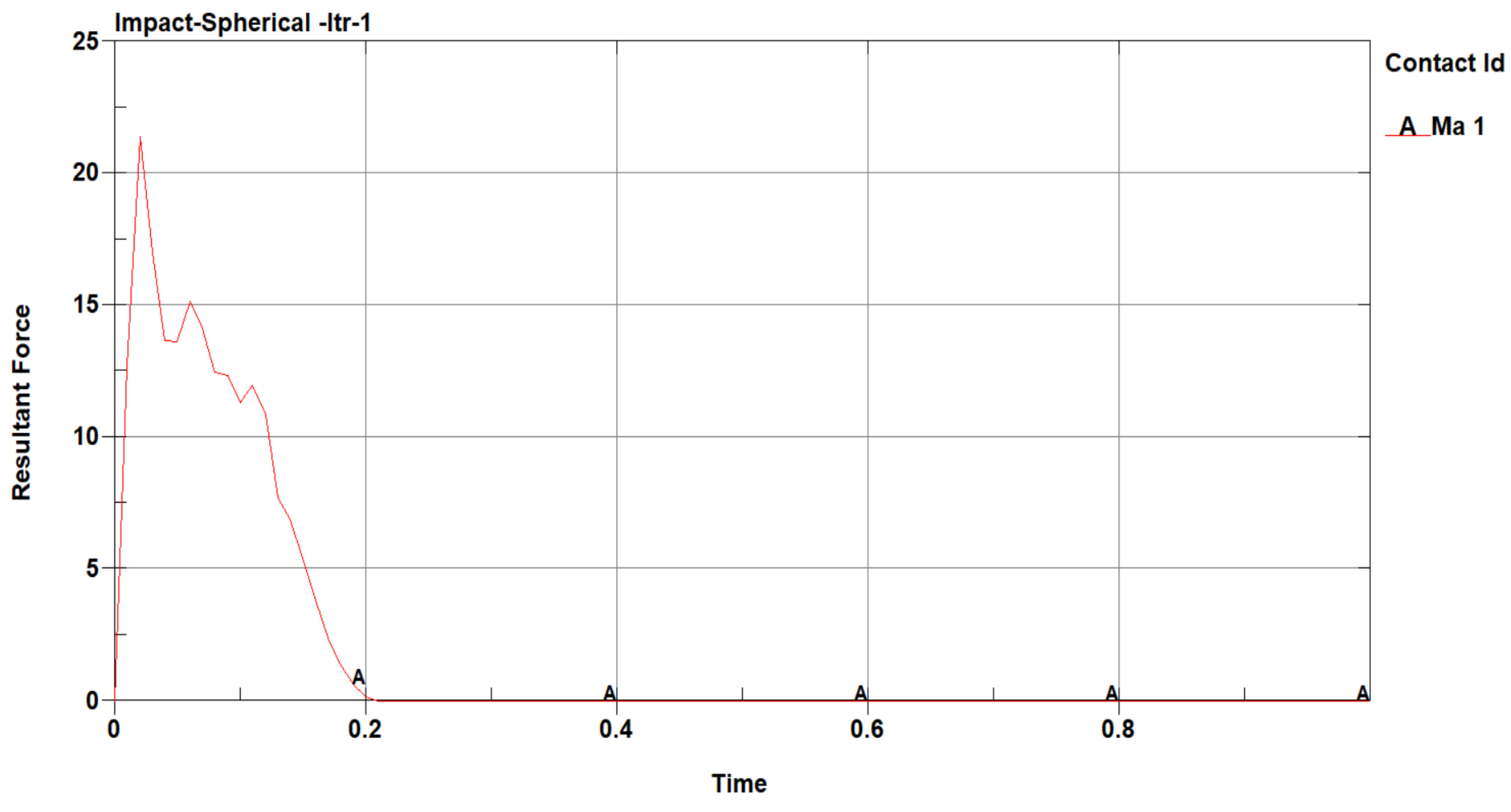
| Mechanical Property | Value |
|---|---|
| Young’s moduli (Longitudinal), E11 | 153 GPa |
| Young’s moduli (Transverse), E22 (E22 = E33) | 10.3 GPa |
| Shear moduli (In-plane), G12 | 5.2 GPa |
| Poisson’s ratios (Major), ʋ12 | 0.3 |
| Tensile strengths (Longitudinal), XT | 2540 MPa |
| Compressive strengths (Longitudinal), XC | 1500 MPa |
| Tensile strengths (Transverse), YT | 82 MPa |
| Compressive strengths (Transverse), YC | 236 MPa |
| Shear strengths, SC | 90 MPa |
| Failures in tension, DFAILT | 0.017 |
| Failures in compressions, DFAILC | 0.0135 |
| Matrix strains, DFAILM | 0.1 |
| Failures in shears, DFAILS | 0.03 |
| Modes I energy release rates, GIC | 225 J/m2 |
| Modes II energy release rates, GIIC | 640 J/m2 |
Disclaimer/Publisher’s Note: The statements, opinions and data contained in all publications are solely those of the individual author(s) and contributor(s) and not of MDPI and/or the editor(s). MDPI and/or the editor(s) disclaim responsibility for any injury to people or property resulting from any ideas, methods, instructions or products referred to in the content. |
© 2023 by the authors. Licensee MDPI, Basel, Switzerland. This article is an open access article distributed under the terms and conditions of the Creative Commons Attribution (CC BY) license (https://creativecommons.org/licenses/by/4.0/).
Share and Cite
Ravinath, G.; Wessley, J.J. LS-Dyna Impact Modelling on Carbon Fibre Reinforced Polymers (CFRP) Composite Aircraft Panel with Various Impactors. Eng. Proc. 2023, 59, 26. https://doi.org/10.3390/engproc2023059026
Ravinath G, Wessley JJ. LS-Dyna Impact Modelling on Carbon Fibre Reinforced Polymers (CFRP) Composite Aircraft Panel with Various Impactors. Engineering Proceedings. 2023; 59(1):26. https://doi.org/10.3390/engproc2023059026
Chicago/Turabian StyleRavinath, Gayathri, and Jims John Wessley. 2023. "LS-Dyna Impact Modelling on Carbon Fibre Reinforced Polymers (CFRP) Composite Aircraft Panel with Various Impactors" Engineering Proceedings 59, no. 1: 26. https://doi.org/10.3390/engproc2023059026






